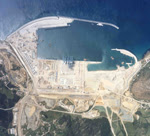
It has been announced that Tanger-Med port will be operational in July as planned. Construction companies have worked flat out to complete the works on schedule. The first customers who wish to use Tanger-Med facilities are now ready to set up in the northern city of Tangier. "As planned, the basic infrastructures of the port were achieved at the end of 2006, meeting the terms of the contract that was signed in 2003," Said Elhadi, the chairman of the Agence Spéciale Tanger Méditerranée (TMSA), told OBG. He added Tanger-Med will receive its first commercial ship this month. In line with its aim to boost foreign investment and integrate into the world economy, Morocco will have a new industrial and commercial complex, located around a port that meets international standards, at the heart of the strait of Gibraltar. Aiming to become a transhipment centre, the complex will be adjacent to the logistic and industrial free trade zones, and linked to the national road, train and telecom network. The new port will emerge as one of the biggest ports in the Mediterranean partly due to its strategic geographical position at the crossroads of three continents. This privileged position will no doubt be key to the success of Tanger-Med, which is poised to serve an immense market of over 90m consumers. "The setting up of Tanger-Med Port comes along with the vision of developing the Northern region," said Jelloul Samsseme, the director of the Regional Centre for Investment (RCI) to OBG. He added that the establishment of Tanger-Med would help to reinforce the region's existing infrastructure, to create new export-oriented free trade zones and to raise the skills level of human resources in the region. Fouad Brini, the general director of the Agency for the Promotion and Economic Development of Northern Provinces (APDN) told OBG that Tanger-Med will not only be the first project initiated from the strategy aiming at integrating the north of Morocco with the rest of the kingdom, but will also facilitate the integration between the northern provinces themselves, especially by setting up facilities that will encourage large-scale activities in the region. Once completed, the facilities will coincide with the inauguration of Tanger-Med. The traffic looks set to explode, with 3.5m containers, more than 1m cars and around 500,000 trucks expected every year. Tanger-Med will also create more than 140,000 jobs over the next 15 years. Mohamed Said Benameur, the chief project director, indicated that about half of the project was accomplished within 18 months. "Since the Tanger Med has been a success, notably in terms of timing, we have already endorsed its extension before the first zone even started to be operational," said Samsseme. The second phase of the project will be 100% funded by the private sector, he added. The new port will be operational in mid-2009, after the completion of the necessary additional construction works, said TMSA. The reason why Tanger-Med already plans to raise its capacity is because sea traffic across the strait is expected to increase significantly. "We expect sea traffic to rise by 7% or 8% in the next five to eight years worldwide. Knowing that the number of containers crossing the strait of Gibraltar represents about 20% of the global traffic, Tanger-Med will consequently be directly affected by the worldwide growth, which will eventually have major consequences for the region," Elhadi told OBG. The positive image of Tanger-Med, which mainly derives from the quality of leading partners - namely Denmark's Maersk Logistics and CMA-CGM - will benefit the northern city at the international level. Elhadi added, "The terminals at the port of Tanger will see a rapid increase in traffic in the coming years. Tanger Med II has been launched in preparation of our existing and potential customers' needs. The project will help to increase significantly the capacity of the port facilities from 2012-2013 onwards."Tanger Med is designed to emerge as an essential transit point for containers travelling from the US to the Middle East or Asia, or vice-versa.
© Oxford Business Group 2007
© Oxford Business Group 2007